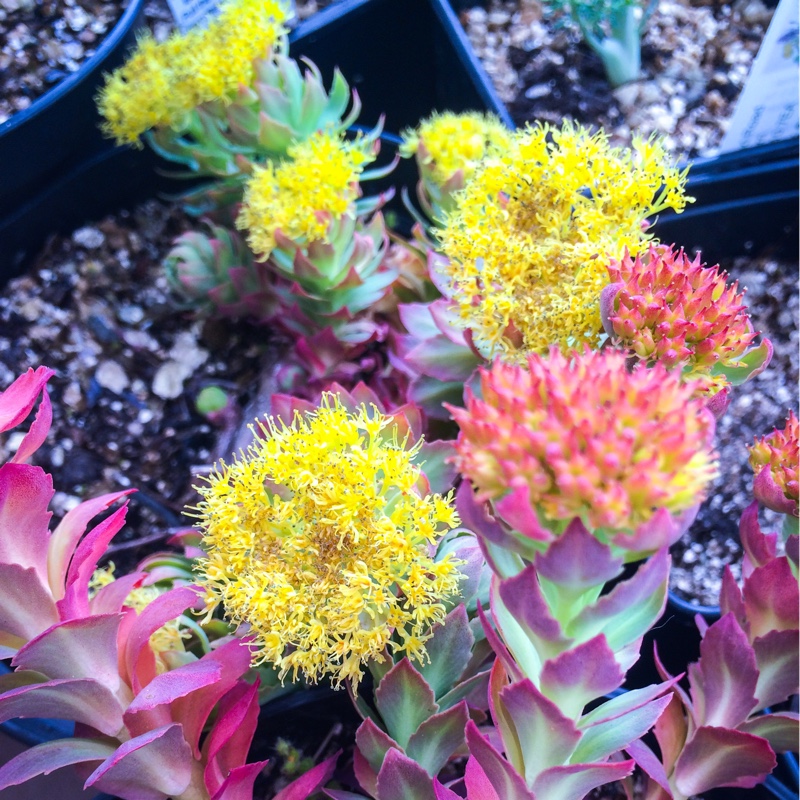
Rhodiola Rosea
Rhodiola 'Rosea'
As per ICN: Description (according to H. Ohba in IHSP, 2003) : Dioecious, 5 – 50 cm tall. Rhizomes cylindrical to long obconical, branched when well developed, 1 – 2 cm in diameter. Flowering stems 1 – 3 (-4 or more), 1 – 6 mm in diameter, glabrous, smooth, pale green, sometimes glaucous. Leaves remote throughout, widely spreading, sessile, oblong or obovate to oblanceolate or ovate (0,4-) 1 – 3 (-4) x (0,3-) 0,6 – 1,7 (-2) cm, pale green, tip often tinged red, ± glaucous beneath, glabrous, smooth, tip round to acute, base shallowly cordate to truncate or round, sometimes amplexicaul, margin nearly entire to irregularly and sparsely serrulate. Inflorescences 25- to 50- (to 70-) flowered, 1 – 2 (-3) x 2 – 4 (-5) cm in diameter, pedicels < 2 mm, smooth. Flowers 3 – 7 mm in diameter, calyx 2 – 2,5 mm, glabrous, lobes linear-subulate to narrowly triangular, 1,8 – 2,3 mm (male) or 2 – 2,7 mm (female), ascending, petals yellow-green, linear to narrowly oblong (male) or linear-subulate (female), 2,5 – 3 (-3.5) mm (male) or 2,2 – 2,5 mm (female), widely spreading (male) or suberect (female); stamens longer than the petals; filaments yellow, (3,5) 4 – 5 mm; anthers yellow.
Contributed by @gardentagssucculentexpert
-
Full sun to partial shade
-
Very little water
-
Frost Hardy: 23F (-5°C)
-
All soil conditions
Common name
Rhodiola 'Rosea'
Latin name
Rhodiola Rosea
type
Perennial
family
Crassulaceae
ph
4.5 - 7.5 Acid - Neutral
Plant & bloom calendar
-
Best time to plant
-
When the plant will bloom
full grown dimensions
 0.45 M
0.30 M
0.45 M
0.30 M
Rhodiola Rosea
As per ICN: Description (according to H. Ohba in IHSP, 2003) : Dioecious, 5 – 50 cm tall. Rhizomes cylindrical to long obconical, branched when well developed, 1 – 2 cm in diameter. Flowering stems 1 – 3 (-4 or more), 1 – 6 mm in diameter, glabrous, smooth, pale green, sometimes glaucous. Leaves remote throughout, widely spreading, sessile, oblong or obovate to oblanceolate or ovate (0,4-) 1 – 3 (-4) x (0,3-) 0,6 – 1,7 (-2) cm, pale green, tip often tinged red, ± glaucous beneath, glabrous, smooth, tip round to acute, base shallowly cordate to truncate or round, sometimes amplexicaul, margin nearly entire to irregularly and sparsely serrulate. Inflorescences 25- to 50- (to 70-) flowered, 1 – 2 (-3) x 2 – 4 (-5) cm in diameter, pedicels < 2 mm, smooth. Flowers 3 – 7 mm in diameter, calyx 2 – 2,5 mm, glabrous, lobes linear-subulate to narrowly triangular, 1,8 – 2,3 mm (male) or 2 – 2,7 mm (female), ascending, petals yellow-green, linear to narrowly oblong (male) or linear-subulate (female), 2,5 – 3 (-3.5) mm (male) or 2,2 – 2,5 mm (female), widely spreading (male) or suberect (female); stamens longer than the petals; filaments yellow, (3,5) 4 – 5 mm; anthers yellow.
Flowering
From Mid Summer TO Mid Autumn
Most sedum flower through the summer months and into early Autumn
Planting
From Early Spring TO Mid Spring
Plant divisions or seeds in Spring
Propagating by seed
From Early Spring TO Mid Spring
Sow seeds in Spring
Propagating by division
From Mid Spring TO Late Summer
Dividing plants for propagation can be done at any time during the growing season, and divisions will grow readily.









